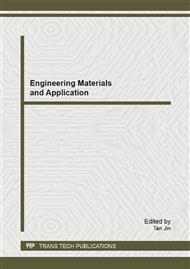[1]
R. Narayanan andI.Y.S. Darwish: Use of steel fibers as shear reinforcement. ACI Struct J Vol. 84, No. 3 (1987), pp.216-227.
Google Scholar
[2]
C.E. Chalioris andE.F. Sfiri: Shear performance of steel fibrous concrete beams. ProcEngVol. 14 (2011), p.2064-(2068).
DOI: 10.1016/j.proeng.2011.07.259
Google Scholar
[3]
C.E. Chalioris and C.G. Karayannis: Effectiveness of the use of steel fibres on the torsional behaviour of flanged concrete beams. Cement & Concrete Composites Vol. 31, No. 5 (2009).
DOI: 10.1016/j.cemconcomp.2009.02.007
Google Scholar
[4]
C.E. Chalioris and C.G. Karayannis: Experimental validation of smeared analysis for plain concrete in torsion. J Structural Engineering, ASCE Vol. 126, No. 6 (2000), pp.646-653.
DOI: 10.1061/(asce)0733-9445(2000)126:6(646)
Google Scholar
[5]
D.G. Aggelis D.V. Soulioti, N.M. Barkoula, A.S. Paipetis and T.E. Matikas: Influence of fiber chemical coating on the acoustic emission behavior of steel fiber reinforced concrete. Cement & Concrete Composites Vol. 34, No. 1 (2012), pp.62-67.
DOI: 10.1016/j.cemconcomp.2011.07.003
Google Scholar
[6]
C. Zeris, A. Vitalis and P. Kontogiannis: Experimental investigation of steel fiber reinforced concrete beams without shear reinforcement (in Greek). Proceedings of the Sixteenth Hellenic Concrete Conference, Pafos, Cyprus(2009).
Google Scholar
[7]
C.E. Chalioris: Steel fibrous RC beams subjected to cyclic deformations under predominant shear. Engineering Structures, accepted paper to appear (2013).
DOI: 10.1016/j.engstruct.2012.10.010
Google Scholar
[8]
C. Juárez, P. Valdez, A. Durán and K. Sobolev: The diagonal tension behavior of fiber reinforced concrete beams. Cement & Concrete Composites Vol. 29, No. 5 (2007), pp.402-408.
DOI: 10.1016/j.cemconcomp.2006.12.009
Google Scholar
[9]
S. Jr. Furlanand J. Bento de Hanai: Shear behaviour of fiber reinforced concrete beams. Cement & Concrete Composites Vol. 19, No. 4 (1997), pp.359-366.
DOI: 10.1016/s0958-9465(97)00031-0
Google Scholar
[10]
K. Watanabe, T. Kimura and J. Niwa: Synergetic effect of steel fibers and shear-reinforcing bars on the shear-resistance mechanisms of RC linear members. Construction& Building Materials Vol. 24, No. 12 (2010), pp.2369-2375.
DOI: 10.1016/j.conbuildmat.2010.05.009
Google Scholar
[11]
Z. You, Y. Ding and C. Niederegger: Replacing stirrups of self-compacting concrete beams with steel fibers. Transactions Tianjin University Vol. 16, No. 6 (2010), pp.411-416.
DOI: 10.1007/s12209-010-1416-0
Google Scholar
[12]
Y. Ding, Z. You and D. Jalali: The composite effect of steel fibres and stirrups on the shear behaviour of beams using self-consolidating concrete. Engineering Structures Vol. 33, No. 1 (2011), pp.107-117.
DOI: 10.1016/j.engstruct.2010.09.023
Google Scholar
[13]
Y. Ding, F. Zhang, F. Torgaland Y. Zhang: Shear behaviour of steel fibre reinforced self-consolidating concrete beams based on the modified compression field theory. Composite Structures Vol. 94, No. 8 (2012), pp.2440-2449.
DOI: 10.1016/j.compstruct.2012.02.025
Google Scholar
[14]
C. Cucchiara, L. Mendolaand M. Papia: Effectiveness of stirrups and steel fibres as shear reinforcement. Cement & Concrete Composites Vol. 26, No. 7 (2004), pp.777-786.
DOI: 10.1016/j.cemconcomp.2003.07.001
Google Scholar
[15]
Z.P. Bažantand J.K. Kim: Size effect in shear failure of longitudinally reinforced beams. ACI J Vol. 81, No. 5 (1984), pp.456-468.
DOI: 10.14359/10696
Google Scholar
[16]
G. Russo and G. Puleri: Stirrup effectiveness in reinforced concrete beams under flexure and shear. ACI Structural J Vol. 94, No. 3 (1997), pp.227-238.
DOI: 10.14359/475
Google Scholar
[17]
S.A. Al-Ta'anand J.R. Al-Feel: Evaluation of shear strength of fibre reinforced concrete beams. Cement & Concrete Composites Vol. 12, No. 2(1990), pp.87-94.
DOI: 10.1016/0958-9465(90)90045-y
Google Scholar
[18]
B.H. Oh: Flexural analysis of reinforced concrete beams containing steel fibers. J Structural Engineering, ASCE Vol. 118, No. 10 (1992), pp.2821-2836.
DOI: 10.1061/(asce)0733-9445(1992)118:10(2821)
Google Scholar
[19]
National Research Council: Guide for the design and construction of fiber-reinforced concrete structures, CNR-DT 204/2006, Rome (2007).
Google Scholar
[20]
C.G. Karayannis: Nonlinear analysis and tests of steel-fiber concrete beams in torsion. J Structural Engineering &Mechanics Vol. 9, No. 4 (2000), pp.323-338.
DOI: 10.12989/sem.2000.9.4.323
Google Scholar
[21]
C.G. Karayannis: Analysis and experimental study for steel fibre pullout from cementitious matrices. Advanced Composites Letters Vol. 9, No. 4 (2000), pp.243-255.
DOI: 10.1177/096369350000900401
Google Scholar


